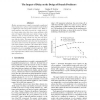Free Online Productivity Tools
i2Speak
i2Symbol
i2OCR
iTex2Img
iWeb2Print
iWeb2Shot
i2Type
iPdf2Split
iPdf2Merge
i2Bopomofo
i2Arabic
i2Style
i2Image
i2PDF
iLatex2Rtf
Sci2ools
MICRO
2000
IEEE
2000
IEEE
The impact of delay on the design of branch predictors
Modern microprocessors employ increasingly complicated branch predictors to achieve instruction fetch bandwidth that is sufficient for wide out-of-order execution cores. While existing predictors can still be accessed in a single clock cycle, recent studies show that slower wires and faster clock rates will require multi-cycle access times to large on-chip structures, such as branch prediction tables. Thus, future branch predictors must consider not only area and accuracy, but also delay. This paper explores these tradeoffs in designing branch predictors and shows that increased accuracy alone cannot overcome the penalties in delay that arise with larger predictor structures. We evaluate three schemes for accommodating delay: a caching approach, an overriding approach, and a cascading lookahead approach. While we use a common branch predictor, gshare, as the prediction component, these schemes can be constructed using most types of predictors.
Related Content
| Added | 31 Jul 2010 |
| Updated | 31 Jul 2010 |
| Type | Conference |
| Year | 2000 |
| Where | MICRO |
| Authors | Daniel A. Jiménez, Stephen W. Keckler, Calvin Lin |
Comments (0)

